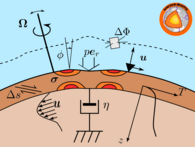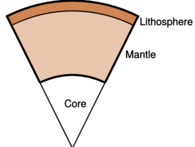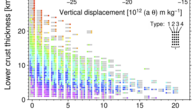Proceses in the solid earth are not accessible directly. The impact of mass redistribution and defromation of the solid earth can be recorded by satellite and surface observations. But, the measurements contain in general a superposition of different processes. Here, numerical models are suitable tool to represent single deformation processes and so separate those in the signal. This model approach demands a proper mechanical description of the solid earth.
The solid earth extends from the earth's surface down to its centre. It usually does not include oceans and atmosphere. The mechanical properties of the solid earth are described by the continuum mechanics approach. This means that the earth is split into small volume elements where for each element the material properties are prescribed. Material properties like density and elastic rigidity may vary with depth, which results in a spherically symmetric structure. General physical principles are applied to describe the interaction between the elements. Integration over the volume gives the response of the entire solid earth to an applied external forcing. Here the lithosphere and mantle are of main interest.
The elastic response to surface loading can be described adequately by linear transfer functions, Green's functions. These are bases on a radially symmetric distribution of density and elasticity and describe the response as a funnction of distance from the load. For small-scale processes the respective local earth structure has to be adjusted accordingly.
For investigations of surface deformations induced by saisonal changes in the terrestrial water cycle or in the atmosphere, the deformation is determined in relation to the elastic crustal stratification (earth structure). As a first approximation, a global set of Green's functions is calculated at each grid point for the respective crust structure which was derived from a laterally heterogeneous crustal-structure model.
References:
Huang, P., Sulzbach, R., Tanaka, Y., Klemann, V., Dobslaw, H., Martinec, Z., Thomas, M. (2021): Anelasticity and lateral heterogeneities in Earth's upper mantle: impact on surface displacements, self‐attraction and loading and ocean tide dynamics. - Journal of Geophysical Research: Solid Earth, 126, 9, e2021JB022332.
Tanaka Y., Klemann V., Martinec Z. (2019) Surface Loading of a Self-Gravitating, Laterally Heterogeneous Elastic Sphere: Preliminary Result for the 2D Case. In: . International Association of Geodesy Symposia. Springer, Berlin, Heidelberg, DOI: https://doi.org/10.1007/1345_2019_62
Dill, R., Klemann, V., Martinec, Z., Tesauro, M. (2015): Applying local Green's functions to study the influence of the crustal structure on hydrological loading displacements. - Journal of Geodynamics, 88, p. 14-2, DOI: https://doi.org/10.1016/j.jog.2015.04.005
Current projects:
From plate tectonics, it is known that the major tectonic plates of the earth behave as if swimming on the earth's mantle. But when considering seismic waves or tides, the Earth's mantle behaves like a solid body. Thus, the same mantle material may react as a fluid or as a solid depending on the time scale of the applied forcing. Viscoelasticity is the mathematical description of this phenomenon: viscous flow of the material for long-time loading of larger than one Million years and elastic deformation for short-time processes (less than a few years). Glacial-isostatic adjustment with characteristic times of 100 to 100,000 yr lies between these two bounds and has to be considered in terms of viscoelaticity.
More recent investigations recommend to consider -- in addition to material compressibility -- the lateral variability of viscosity which is derived from geodynamics, in order to describe the deformational behaviour of the solid earth realistically.
See also: Density Structure of the Earth
References:
Bagge, M., Klemann, V., Steinberger, B., Latinovic, M., Thomas, M. (2021): Glacial-isostatic adjustment models using geodynamically constrained 3D Earth structures. - Geochemistry Geophysics Geosystems (G3), 22, 11, e2021GC009853.
Tanaka, Y., Hasegawa, T., Tsuruoka, H., Klemann, V., Martinec, Z. (2015): Spectral-finite element approach to post-seismic relaxation in a spherical compressible Earth: application to gravity changes due to the 2004 Sumatra-Andaman earthquake. - Geophysical Journal International, 200, p. 299-321. | GFZpublic | doi.org/10.1093/gji/ggu391 | URI | PDF |
Cambiotti, G., Klemann, V., Sabadini, R. (2013): Compressible viscoelastodynamics of a spherical body at long timescales and its isostatic equilibrium. - Geophysical Journal International, 193, 3, p. 1071-1082.| GFZpublic | doi.org/10.1093/gji/ggt026 | PDF |
Klemann, V., Martinec, Z., Ivins, E. R. (2008): Glacial isostasy and plate motion. - Journal of Geodynamics, 46, 3-5, p. 95-103. | GFZpublic | http://doi.org/10.1016/j.jog.2008.04.005 | PDF |
Current projects:






